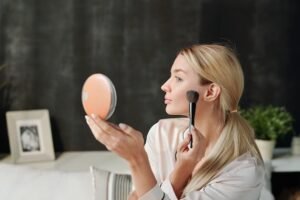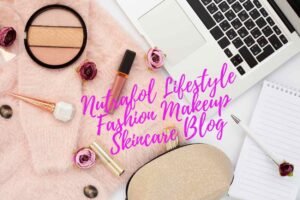Creating a skincare routine is not about following trends or copying what others do. It is about understanding your skin, knowing what it needs, and applying the right steps consistently. This guide will help you build a skincare routine from scratch using a simple approach. We will go through each step, explain why it matters, and offer real tips to make it work for you.
1. Understand Your Skin Type
Before starting any skincare routine, it is important to know your skin type. This helps you choose the right products and avoid those that might cause problems.
Skin types include:
| Skin Type | Characteristics |
|---|---|
| Oily | Shiny skin, large pores, prone to acne |
| Dry | Flaky, rough patches, dull complexion |
| Combination | Oily in some areas (like T-zone), dry in others |
| Sensitive | Reacts easily, redness, itching, stinging |
| Normal | Balanced, few breakouts, smooth texture |
Tip: Wash your face and wait 30 minutes without applying anything. If it feels tight, you may have dry skin. If it gets shiny, you may have oily skin. If only your nose and forehead are oily, that is combination skin.
2. Start With a Gentle Cleanser
Cleansing helps remove dirt, sweat, and makeup. A gentle cleanser cleans your face without stripping away natural oils.
What to look for in a cleanser:
- Fragrance-free if you have sensitive skin
- Gel-based for oily skin
- Creamy for dry skin
Common Cleansing Mistakes:
- Using hot water, which can irritate skin
- Using harsh soaps
- Over-washing, which causes dryness
Expert Insight: Dermatologist Dr. Amy Li says, “Cleaning the face twice a day, morning and night, helps prevent buildup and keeps the pores clear.”
3. Use a Toner (Optional But Helpful)
Toners help balance the skin’s pH level and remove leftover residue after cleansing. They can also prepare the skin to better absorb products.
Different types of toners:
| Toner Type | Purpose |
| Hydrating | Adds moisture for dry or normal skin |
| Exfoliating | Helps with acne or rough texture |
| Calming | Reduces redness for sensitive skin |
Tip: Apply toner with a cotton pad or pat it in with your hands. Avoid alcohol-based toners as they can dry out the skin.
4. Apply Serum for Targeted Treatment
Serums contain active ingredients that target specific skin concerns such as dullness, dark spots, or fine lines.
Common types of serums:
| Concern | Recommended Serum Ingredient |
| Dryness | Hyaluronic Acid |
| Dull Skin | Vitamin C |
| Acne | Niacinamide or Salicylic Acid |
| Aging Signs | Retinol or Peptides |
| Redness | Centella Asiatica or Green Tea |
Expert Tip: Always apply serum before thicker products. Use 2–3 drops and press it gently into the skin.
5. Moisturize to Lock In Hydration
Moisturizer helps keep the skin hydrated and forms a protective layer to prevent moisture loss.
Choosing the right moisturizer:
| Skin Type | Recommended Moisturizer Type |
| Oily | Lightweight gel or water-based |
| Dry | Rich cream or oil-based |
| Sensitive | Fragrance-free, calming ingredients |
Important Note: Do not skip moisturizer even if your skin is oily. Dehydrated skin can produce more oil to compensate.
6. Never Skip Sunscreen (Daytime)
Sunscreen protects the skin from UV damage, which causes premature aging, dark spots, and even skin cancer.
Choosing sunscreen:
- Use SPF 30 or higher
- Broad-spectrum for UVA and UVB protection
- Non-comedogenic if you have acne-prone skin
Apply sunscreen every morning, even on cloudy days. Reapply every 2–3 hours if outside.
7. Exfoliate Weekly for Smooth Skin
Exfoliation removes dead skin cells and promotes fresh, healthy skin. But overdoing it can cause irritation.
Types of exfoliants:
| Type | Examples | Use Frequency |
| Physical | Scrubs with grains or beads | Once a week |
| Chemical | AHAs (like glycolic acid), BHAs | 1–2 times a week |
Warning: Do not mix strong exfoliants with retinol or vitamin C without professional guidance.
8. Add Eye Cream (Optional)
The skin around your eyes is thinner and more delicate. Eye creams can help reduce puffiness, dark circles, and fine lines.
What to look for in eye cream:
- Caffeine for puffiness
- Peptides for firmness
- Hyaluronic acid for hydration
Tip: Use your ring finger to tap gently. Don’t rub.
9. Night Care Is Important Too
Nighttime is when the skin repairs itself. Your night routine should include:
- Cleansing
- Toner
- Serum
- Moisturizer
- Spot treatment (if needed)
Optional Night Products:
- Overnight masks for hydration
- Retinol for anti-aging (use only at night)
10. Stay Consistent and Be Patient
Skincare is not instant. Most products need time to show results. Consistency is key.
Realistic Timelines for Results:
| Product Type | Expected Result Time |
| Cleanser | 1 week |
| Serum | 4–6 weeks |
| Moisturizer | 1–2 weeks |
| Sunscreen | Prevents damage daily |
| Retinol | 8–12 weeks |
11. Adjust as Your Skin Changes
Skin can change due to seasons, stress, diet, or age. Review your routine every few months and adjust if necessary.
Situations that may require a change:
- Weather change (summer vs. winter)
- Hormonal shifts
- New skin concerns (acne, dryness, redness)
12. Avoid Overcomplicating
A skincare routine doesn’t need 10+ products. Start with basics:
- Cleanser
- Moisturizer
- Sunscreen (day)
Add products slowly and only if needed.
13. Budget-Friendly Tips
Good skincare doesn’t have to be expensive. Look for value products that work well. Some drugstore brands offer excellent options.
Affordable ingredients that work:
- Niacinamide
- Hyaluronic Acid
- Glycerin
- Ceramides
Tip: Read product labels. Expensive doesn’t always mean better.
14. Don’t Follow Trends Blindly
Just because something is popular doesn’t mean it suits your skin. Stick to what works for you.
Red Flags in Trends:
- DIY recipes with lemon or baking soda
- Over-exfoliation
- Using too many active ingredients at once
15. Learn From Experts, But Trust Your Experience Too
Skincare professionals can offer great advice. But your own observation is valuable too. Keep track of what works and what doesn’t.
Useful ways to track progress:
- Take photos weekly
- Write down product reactions
- Watch how your skin behaves each season
This guide offers a complete way to build your skincare routine step by step. You do not need every product from the beginning. The goal is to understand your skin and meet its needs consistently and simply. With time and care, your skin will thank you.







